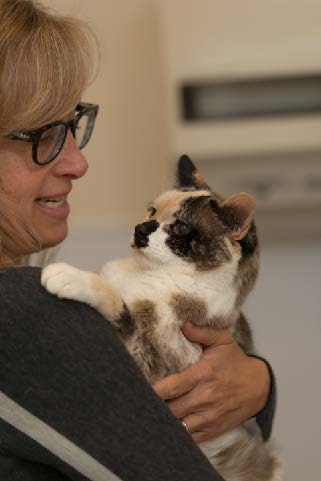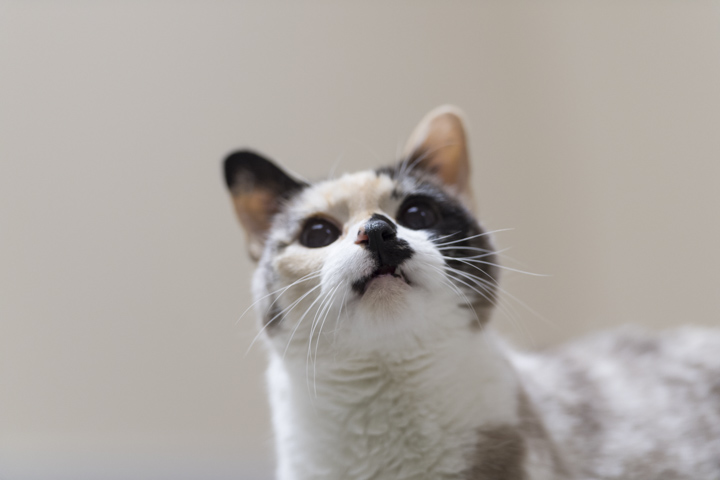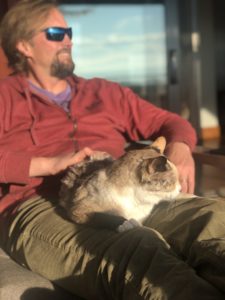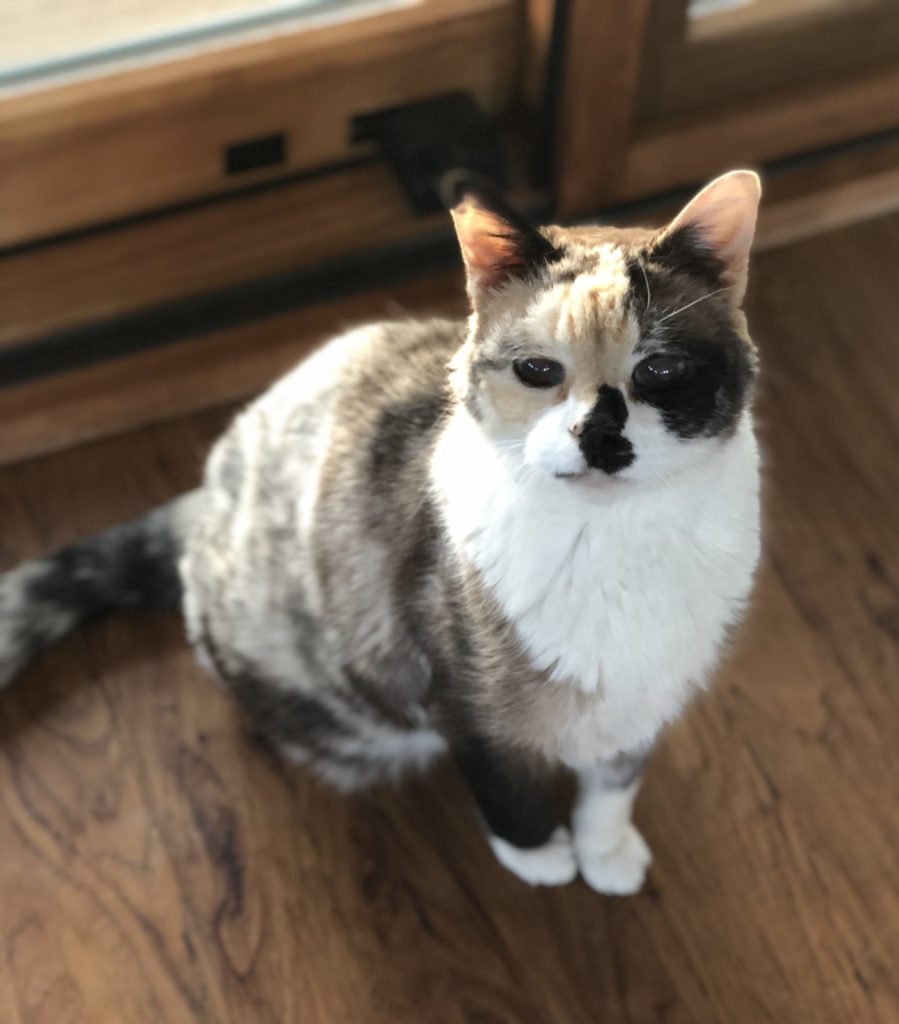By Dr. Christine Hardy
Illustration by Billy Babb
Her life was beautiful. Her death was too.
Squeakers came into my life 20 years ago, after a Good Samaritan found her on a country road and dropped her off at a veterinary clinic with $50 to “do what was best.” The calico-Siamese mix was dirty and half-alive, but stable enough to wait for the doctor to complete the morning’s surgeries. A few years pre-veterinary school, I wasn’t qualified to assess her medical status myself, but as a seasoned farm kid I knew what was coming. I set about making her as comfortable as possible for her final hours by piling up plush blankets freshly out of the dryer.

By the time the surgeries were done, she was sitting up and very much alive, eyes wildly bouncing back and forth, a nystagmus from her head trauma. Maybe she knew she had to both decide to live and communicate this desire obviously, lest the decision be left up to those with a “higher plane of reasoning.” Smart cat. And so, what was best for her was time, a good cleaning of her minor wounds, antibiotics, pain meds, and healing wishes.
Squeakers lived at the clinic for a few weeks, until I took her home. She had ice-blue eyes that continued to exhibit the nystagmus, albeit more slowly, a condition associated with Siamese cats. The movement of her eyes was like a comforting metronome, and her voice was more of a squeak than a meow, counterbalances to her otherworldly beauty.
In the years that my husband, Erik, and I shared our home with Squeakers (or perhaps the other way around), she mastered the skill of listening so deeply, completely, and without judgment that she actually invited you to think things through to resolution on your own, like a good therapist does.
She squeaked encouragement: You’re OK. Don’t doubt yourself so much. I hear you, sister. Hang on there, is there another interpretation? Just be with it for a bit and see what emerges. Atta girl! I knew you could!
She always knew what to say at just the right moment. Even when I briefly doubted my presence on this planet, she reassured me in her squeakin’ way that there would be another ray of sunshine. She was always right.

Squeakers lived masterfully, even after her chronic kidney disease diagnosis in 2014. Kidney disease is common in older cats and is managed primarily through diet and regular monitoring. In 2019, the discovery of congestive heart failure upped the stakes. It was a high-wire act between her kidneys wanting all of the fluids and her heart wanting none. Eventually, she would literally drown in the fluids that accumulate in the lungs as the heart fails. I have witnessed this type of death, and it still wakes me at night. I vowed to spare her that end.
On March 17, 2020, her breathing became more labored. We could no longer increase her medications to alleviate the symptoms. She had become resistant to the megadoses she was now on, a sign of the terminal phase of her disease. It was like walking up a slippery slope on which you maintain traction until the angle increases just enough to make it impossible to not slide backward. We had passed the angle of repose and lost all hope of reaching the summit. Erik and I had talked at length and agreed we couldn’t put her through that kind of suffering. Or perhaps it is more accurate to say we couldn’t put ourselves through her slow, internal drowning with no way to alleviate her symptoms.
When Squeakers spread her front legs, lengthened her neck, and started using her abdominal muscles in earnest to aid her labored breathing, it was time to help her pass. Erik hugged her while I administered an anesthetic agent. Once she was fully anesthetized, I administered the drug to stop her heart. With the push of a plunger, I invited death in. Erik and I silently sent forth all of our love for her. Within seconds, she was released from her failing body. She eased into death in the way she passed through most of her life, beautifully and effortlessly.
She eased into death in the way she passed through most of her life, beautifully and effortlessly.
It wasn’t the hardest euthanasia I’ve performed. That was Sam, my first dog – our first dog. I was the agent of his transition too. Sam passed beautifully and peacefully under a tree in our backyard with a belly full of steak and ice cream to fuel him to the beyond. Had we changed course, a raging case of pancreatitis was guaranteed. Sam had been my companion since college, through graduate school, career changes, marriage, moving to Colorado, our first house, and veterinary school. I knew his death would be hard, but I didn’t anticipate how his loss would gut me. The despair I felt was a reflection of the nearly 13 years our lives overlapped. The depth of my grief was equal to the love we had for each other.
Why did I choose to be the agent of death for my animals? On the surface, it might seem like a very odd way to express my love to Squeakers (and Sam, Owen, Oskar, Ryder, and Winston) but I knew this act – before panic or struggle set it, when she was still aware of our love – would fulfill our promise to spare her the kind of suffering that causes nightmares.
It is also the fulfillment of my unspoken promise to Erik to help us share these experiences in a way that is true to us. The inscription inside the wedding rings we’ve worn for nearly 22 years is Always you and me. With only our little family unit present, we are free to be completely ourselves at the moment of loss.

As a veterinarian, I have helped many animals to pass. I have ultimately decided it is a privilege to end suffering when there is no way to alleviate misery. Some people argue that struggle is the natural order of birth and death. I don’t disagree that the struggle may be sacred, but ultimately, I’m willing to bear the responsibility for depriving creatures of suffering that can’t otherwise be relieved.
Regardless of the situation, I always try to facilitate and support the animal and their family with empathy. Whenever possible, I encourage the family to be present and to make the experience their own. I endeavor to calmly, efficiently, and effectively invite death in the least traumatic of ways. My hope is that the euthanasia never takes away from the shared time that preceded it nor becomes an obstacle to healing for the family. In short, the transition is difficult enough; my goal is to not add any more strife to the situation.
I share Squeakers’ story without judgment for anyone else or any other situation. Inviting death so directly is not for everyone, even veterinarians, farmers, or ranchers, all of whom find themselves at the intersections of life and death more often than most people. The luxury to plan such a transition is not always possible. Sometimes difficult decisions have to be made in emergency situations.
In these moments, it becomes even more critical to put ourselves and our needs just behind the needs of the animal we bear responsibility for and advocate for. That means we sometimes need to put aside the peace and beauty of a well-orchestrated plan to make immediate decisions … right now, in spite of where we are or with whom we find ourselves.
As a veterinarian, I have helped many animals to pass. I have ultimately decided it is a privilege to end suffering when there is no way to alleviate misery.
Over time, I’ve made some sort of peace with death. And loss, of which death is one type. Death and loss are inescapable parts of life. I’ve learned that being fearful or trying to avoid them only makes it worse. When bad thoughts are relegated to the mind’s basement, they lift weights only to emerge stronger. I know better than to suppress my feelings, but when Squeakers died, I didn’t speak a word about the loss, even though she was a family member for 20 years. Her death seemed insignificant compared to what was happening in the world last March – COVID-19, a rising death toll, and school and workplace shutdowns.
Instead, I quietly escorted my feelings about her straight to the basement of my mind where they joined forces with old emotions that had taken up residence years earlier. Like so many other women, I had put my career before having a family, never imagining that science, if needed, wouldn’t rise to the challenge. At the time, I was in my mid- to late 30s. Women have children all the time at this age, even into their 40s. What’s the rush?
But even science has its limitations, and when our five-year journey with infertility ended without a child, the loss was profound. The few months of therapy in the immediate aftermath helped with the acute pain, but it wasn’t enough to work through the bigger questions about life’s purpose and meaning, many of which emerged over time.
Squeakers’ death awakened those feelings, and the old loss (and big secret) became training partners with the new, lifting weights as if they were preparing for the Olympics. What emerged was so strong and fierce that the overwhelming sadness literally sat me down. My brain couldn’t logic its way to resolution for these matters of the heart and soul.
I finally sought out an amazing professional counselor who helped me work through some of these questions and more constructively carry this part of my life story. This is a work in progress. Squeakers’ death will not be the last loss I experience. The basement isn’t empty. And I know I am not alone, even when it feels that way.
Stepping into feelings is a choice. Just like escorting them to the basement was. Seeking help for a problem I couldn’t solve on my own? Also, a choice. A good one.
The less I’ve suppressed my feelings about death and the more I allow myself to feel all the feels as they happen, the more at peace with this part of life I have become. This peace has helped me focus on the gratitude I feel for shared Earth time. And, the love never dies. Today, I smile and laugh when telling stories of any of our fur family members, including Squeakers. The same is true for the human friends and family who have passed away.
Shining the light on parts of my story. Another choice. As was holding onto the secret. So many choices! To be honest, sharing all of this is only slightly less terrifying, painful, and exhausting than continuing to try and keep that basement door closed.
We don’t come preloaded with the skills or capacity to deal with everything we will encounter through life. I can only hope everyone will be connected to someone who can help them back to the path of mental wellness when they venture away. I’ve learned that by shining the light on these feelings they start to lose their power, and it becomes possible to find hidden gifts and even gratitude. Loss comes in many forms and also needs to be seen, heard, and felt. Ideally, as it happens or as the feelings and questions arise, lest they become Olympic heavyweight champions in the mind’s basement.
The veterinary profession is finally starting to recognize that the ups and downs of life combined with our unique professional responsibilities are complicated and need attention, discussion, and action. It’s far too easy to compartmentalize these feelings or even to falsely think we can completely separate our personal lives from our professional responsibilities. Doing so denies a principal part of our humanity.
Every last one of us has experienced loss and isolation over the last year due to the pandemic. We need more connection, but have been forced to be distanced. Our pre-existing struggles may be magnified by isolation and pose a real risk to populating the mind’s basement. Resist! The need to be physically distanced doesn’t mean we need to be emotionally or socially isolated. Connection can still happen.
I know this exploration honors Squeakers and the meaning of her life. For this and the ability to spare her the terminal phase of her suffering, I’m grateful. Her life story also became a catalyst to repack a heavy burden of mine in a different way. By shining a light on this part of my greater life story, those overwhelming feelings of sadness have lost some of their avoirdupois. I can almost hear her saying, Atta girl! I knew you could! And amazingly, what has emerged is a sense of lightness, gratitude, and empowerment.
My favorite quote is “Gratitude is the memory of the heart.” And my heart is full – but in a light and fulfilling way. And my mind’s basement is less burdensome. A new and hopeful perspective is revealed. It is slower to emerge, but I’ve started to find peace and purpose in a life that is different than we imagined and hoped for. Life is like that. Peace can come from stepping into discomfort. Healing can emerge from devastation. Life and love from loss. Gratitude emerges in spite of grief, maybe even because of it.

Dr. Christine Hardy is a 2007 alumna of the CSU D.V.M program, and leads operations and strategy at CSU’s Flint Animal Cancer Center.